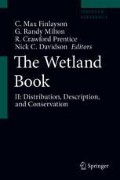Abstract
Sembilang National Park with Berbak National Park (a Ramsar Site) to the north is part of the Greater Berbak-Sembilang Ecosystem on the Indonesian island of Sumatra and comprises the largest mangrove area (77,500 ha) of the Indo-Malayan region and the only mangrove area that still has an intact natural transition into adjacent freshwater and peatswamp forest. It is an important breeding and nursery area for fish and shrimp and one of the most important areas for resident and migratory waterbirds in Southeast Asia. The peatland area in Sembilang NP is approximately 31% of total park area and constitutes a huge carbon store estimated at around 164 million tons. Officially designated in 2011 as one of Indonesia’s Ramsar Sites, the most serious threat to the area is rapid degradation of the peat swamp forest outside of the park boundaries, involving illegal logging as well as the conversion of large areas to cultivation of oil palm or Acacia (for pulp wood for paper production). The peat domes that support the peat swamp forests in the national park are only partly covered by the protected area, and drainage (including legal drainage) outside of the park may strongly impact the eco-hydrology of the protected area. About 3,000 ha of mangrove in the eastern part of the park converted for aquaculture since 1995 has been subsequently included in the park’s restoration zone, and in 2013 a mangrove restoration project was initiated. The park is still threatened by external developments including a harbor project and plantations.
References
Danielsen F, Skov H. Waterbird study results from South East Sumatra. Oriental Bird Cl. Bull. 1987;6:8–11
Danielsen F, Verheugt WJM. Integrating conservation and land-use planning in the coastal region of South Sumatra. Bogor: PHPA/AWB-Indonesia; 1990.
Danielsen F, Purwoko A, Silvius MJ, Skov H, Verheugt W. Breeding colonies of Milky Stork in South Sumatra. Kukila. 1991a;5(2):133–5.
Danielsen F, Skov H, Suwarman U. Breeding colonies of waterbirds along the coast of Jambi Province, Sumatra, August 1989. Kukila. 1991b;5(2):135–8.
Hooijer A, Page S, Jauhiainen J, Lee WA, Lu XX, Idris A, Anshari G. Subsidence and carbon loss in drained tropical peatlands. Biogeosciences. 2012;9:1053–71.
Iqbal M, Mulyono H, Riwan A, Takari F. An alarming decrease in the Milky Stork Mycteria cinerea population on the east coast of South Sumatra Province. Indones Birding Asia. 2012;18:68–70.
Liedel K. Verbreitung und Okologie des Steppenschlammläufers, Limnodromus semipalmatus (Blyth). Ergebnisse der Mongolischn Gemeinschaftsreise von Ornithologen aus der DDR 1979. XI. Mitt. Zool. Mus. Berlin. Bd. 58, Suppl: Ann Orn. 1982; 6:147–162.
Olviana EK. Pendugaan populasi harimau Sumatra Pantera tigris sumatrae, Pocock 1929 menggunakan metode kamera jebakan di Taman Nasional Berbak. Bogor Agricultural University (IPB); Bogor, Indonesia, 2011.
Rosalina U, Rahayu S, Permana E, Suryawan SI, Hidayat A, Waluyo. Laporan Final Delineasi Potensi Proyek Carbon dan Pendugaan Cadangan Carbon pada areal kegiatan proyek (Carbon Stocks in Pilot Sites at Project Commencement). Fakultas Kehutanan IPB – Wetlands International; Bogor, Indonesia, 2003/2004.
Silvius MJ. On the importance of Sumatra’s east coast for waterbirds, with notes on the Asian Dowitcher Limnodromus semipalmatus. Kukila. 1988;3(3/4):117–37.
Silvius MJ. Survey of coastal wetlands in Sumatra Selatan and Jambi, Indonesia. March/April 1986. Kuala Lumpur: PHPA- Interwader Report No.:1; 1986.
Silvius MJ, Verheugt WJM, Simons HW. Soils, vegetation, fauna and nature conservation of the Berbak Game Reserve, Sumatra, Indonesia, RIN contributions to Research on Management of Natural Resources, vol. 1984-3. Arnhem: Research Institute for Nature Management; 1984.
Silvius MJ, Verheugt WJM, Iskandar J. Coastal wetlands inventory of Southeast Sumatra. Report of the Sumatran Waterbird Survey Oct–Dec 1984. Cambridge: ICBP study report No.: 9; 1986.
Verheugt WJM, Purwoko A, Danielsen F, Skov H, Kadarisman R. Integrating mangrove and swamp forests conservation with coastal lowland development; the Banyuasin Sembilang swamps case study, South Sumatra Province, Indonesia. Landscape Urban Ecol. 1991;20(1–3):85–94.
Verheugt WJM, Skov H, Danielsen F. Notes on the birds of the tidal lowlands and floodplains of South Sumatra Province Indonesia. Kukila. 1993;6(2):53–84.
Wibowo P. The greater Berbak Sembilang integrated coastal wetland conservation project. Project final report. Wetlands International Indonesia Programme, Bogor; 2004.
Author information
Authors and Affiliations
Corresponding authors
Editor information
Editors and Affiliations
Rights and permissions
Copyright information
© 2018 Springer Science+Business Media B.V., part of Springer Nature
About this entry
Cite this entry
Silvius, M.J., Noor, Y.R., Lubis, I.R., Giesen, W., Rais, D. (2018). Sembilang National Park: Mangrove Reserves of Indonesia. In: Finlayson, C., Milton, G., Prentice, R., Davidson, N. (eds) The Wetland Book. Springer, Dordrecht. https://doi.org/10.1007/978-94-007-4001-3_213
Download citation
DOI: https://doi.org/10.1007/978-94-007-4001-3_213
Published:
Publisher Name: Springer, Dordrecht
Print ISBN: 978-94-007-4000-6
Online ISBN: 978-94-007-4001-3
eBook Packages: Biomedical and Life SciencesReference Module Biomedical and Life Sciences

